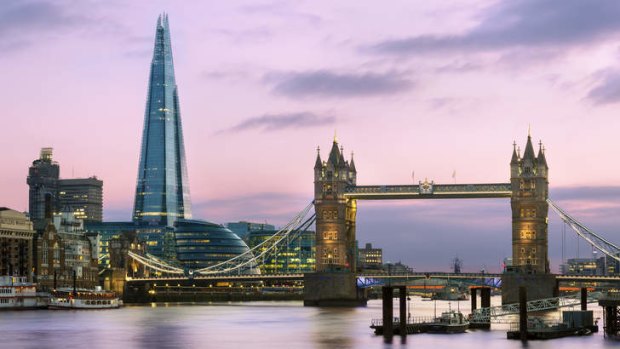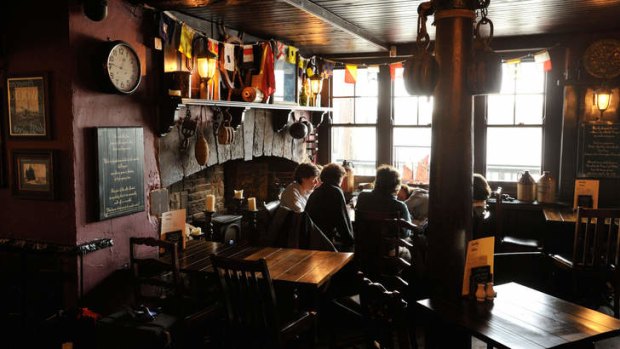
Past and present: The Shard, London Bridge and Tower Bridge at dusk.Credit: Getty Images
Via tunnels, towers and bridges, Kendall Hill discovers some of London's most engaging yet lesser known attractions and stories.
On a brisk December day Sophie Campbell bundles us out of our hotel foyer and on to the East London overground for an afternoon of Dickens, death and even a polar bear.
Our destination is Wapping, the capital's maritime heart now, like much of the East End, gussied up and glowing with renewed vigour. East is the new west.

The interior of Prospect of Whitby pub, Limehouse.Credit: Alamy
"On old maps, the City of London is as east as you would go," says Campbell, a Blue Badge guide and Telegraph heritage writer. "Beyond that was Terra Incognita."
The orange line threads through grunge-to-gentry suburbs such as Canonbury and Dalston Junction, the haunt of artists and creatives who can't afford Islington. Campbell's commentary is informative and fun, noting places of interest including Shoreditch High Street and the Geffrye Museum of Domestic Interiors.
We disembark at the entrance to the Thames Tunnel, Marc Brunel and son Isambard's pioneering river underpass, and climb the spiral stairs to pop up in Wapping and wander streets lined with stone and brick warehouses.
The streetscapes date from the early 19th century when this part of town was all about building and supplying ships. Today, the wharves house slick apartments for the upwardly mobile and smart public housing to preserve the working-class character of the Docklands.
We pause to admire a Tudor pub, the Prospect of Whitby, with its pewter-topped bar that probably dates from when Henry VIII was on the throne. Keats and Dickens used to drink here.
Beside it are the Pelican Stairs, which lead to the Thames at low tide and a spell of mudlarking - scouring the riverbed for any lost property of value.
Back at street level there's an antique pub on every corner.
The Captain Kidd was named after the famous pirate hanged in 1701 from the riverside gibbet at Execution Dock. The bodies of the dispatched would be left at Wapping Old Stairs until the tide had washed over them three times and swelled their corpses into "whoppers". Hence Wapping.
Or so Campbell says.
Sometimes the history of London is so colourful it seems incredible.
On Wapping High Street we discover the headquarters of the world's first uniformed police force, the Thames River Police, formed in 1798 to protect the West India dock's valuable cargo and prevent looting from ships anchored in the Pool of London.
At Pierhead Wharf, former home of dock officials, actor Helen Mirren lives in a grand terrace with curved windows gazing across to the thrusting glass landmarks of Canary Wharf. The Shard and the Gherkin glimmer further down the river.
The old headquarters of the London Hydraulics Company is now the Wapping Project - a combined art gallery, installation space and restaurant.
Tower Bridge looms ahead. Prostitutes once plied their trade on the upper walkways, where only genuine customers would bother climbing all those stairs to find them. Campbell much prefers the Gothic glory of Tower Bridge to its concrete and steel neighbour further along the river.
"London Bridge is the most boring bridge in London," she says of the drab span completed in 1973. "It used to have houses on it and heads on pikes but it's much less jolly now."
She turns her attention to the Tower of London, the easternmost fortress of the stone ring that once protected the capital (Windsor Castle was the westernmost). There's Traitors Gate, she says, where Ann Boleyn emerged in a crimson dress on her wedding day and where she returned three years later to await execution.
Lion Gate was named for the lions once kept here as a "natural" defence - part of the menagerie that used to occupy the tower. "There was also a polar bear that was kept in the moat and was, surprisingly, allowed out occasionally to catch fish in the Thames," Campbell says.
As late as 1829, the Royal Menagerie was home to dozens of exotic creatures including llamas, a jaguar and kangaroos. After one too many escapes and attacks, the animals were transferred to the new London Zoo.
Sophie Campbell tailors London tours to suit guest interests; sample itineraries include Westminster to the Isle of Dogs, and Lambeth Palace to the Greenwich Observatory. See love-london.com.
The writer travelled to London courtesy of Qantas and the Pullman St Pancras.
Sign up for the Traveller Deals newsletter
Get exclusive travel deals delivered straight to your inbox. Sign up now.